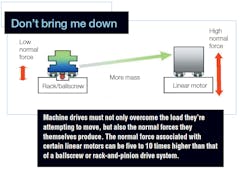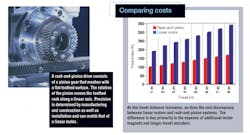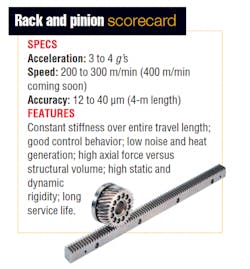Rack and pinions are the other precision linear drive. In concept, they're one of the oldest and most basic power transmission technologies. They consist simply of a pinion gear meshing with a toothed bar or “rack.” Although either component may be fixed, it’s usually the pinion, which when rotating, forces the rack to move laterally in the direction of rotation.
Depending on how they are manufactured, rack-and-pinion drives can deliver very precise motion, rivaling or exceeding that of ballscrews and even linear motors.
When combined with high-end servo actuators, precision rackand- pinion drives can hold less than 1 arc-min of backlash, true running of 10 μm, and 98.5% efficiency. Such drives are employed in many precision applications, including high-speed metal cutting, laser cutting, grinding machines, and woodworking machines. Other applications include automatic assembly equipment and gantries.
Rack-and-pinion questions & answers
Q: How is accuracy maintained?
A: The accuracy of a precision rack-and-pinion system is around 12 μm per 500-mm rack. By matching sections — each section is checked and marked — lengths of any size can be created with no more than 40 μm of position error.
Q: Is mounting difficult?
A: In the case of precision drives, tight tolerances tend to simplify the mounting process. The first step is to prepare the racks and machine bed, paying close attention to parallelism. No shims or adjustments should be necessary. Subsequent rack lengths may be added with the help of an assembly jig. Mounting a section of rack this way takes no more than 20 minutes.
Information provided by Klaus Bauer, product manager, and Mike Anselmo, applications engineer, Alpha Gear Drives Inc., Elk Grove Village, Ill.
About the Author
Elisabeth Eitel
Elisabeth Eitel was a Senior Editor at Machine Design magazine until 2014. She has a B.S. in Mechanical Engineering from Fenn College at Cleveland State University.



